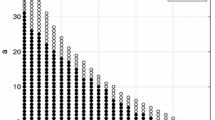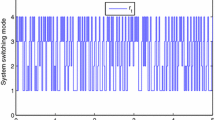Abstract
This paper studies the mixed \(H_2/H_\infty\) control for Takagi–Sugeno (T–S) fuzzy Markovian jump systems (MJSs) subject to random delays and multiple uncertain transition probabilities. In contrast to existing research, this study presents uncertainty parameters, external disturbance, random delays, and uncertain transition probabilities simultaneously in a unified T–S fuzzy model. Specifically, this study examines multiple Markov chains with partially unknown transition probabilities. These complex imperfections have a substantial adverse impact on system performance and the associated challenge of mixed \(H_2/H_\infty\) control remains unresolved. Our innovative contributions are described as follows. The proposed approach utilizes free-weighting matrix technique and Lyapunov–Krasovskii functional to get the \(H_2/H_\infty\) controller, which ensures that the stochastic T–S fuzzy systems exhibit stochastic stability and comply with the \(H_\infty\) performance index.







Similar content being viewed by others
Data availability
No data was used for the research described in the article.
References
Hou, T., Ma, H.: Exponential stability for discrete-time infinite Markov jump systems. IEEE Trans. Autom. Control 61(12), 4241–4246 (2016)
Lin, H., Su, H., Shu, Z., et al.: Optimal estimation in udp-like networked control systems with intermittent inputs: stability analysis and suboptimal filter design. IEEE Trans. Autom. Control 61(7), 1794–1809 (2016)
Tan, C., Gao, C., Zhang, Z., et al.: Non-fragile guaranteed cost control for networked nonlinear Markov jump systems under multiple cyber-attacks. J. Franklin Inst. 360(13), 9446–9467 (2023)
Yang, H., Xu, Y., Zhang, J.: Event-driven control for networked control systems with quantization and Markov packet losses. IEEE Trans. Cybern. 47(8), 2235–2243 (2017)
Grillo, S., Pievatolo, A., Tironi, E.: Optimal storage scheduling using Markov decision processes. IEEE Trans. Sustain. Energy 7(2), 755–764 (2016)
Li, F., Xu, S., Shen, H.: Fuzzy-model-based \(H_\infty\) control for Markov jump nonlinear slow sampling singularly perturbed systems with partial information. IEEE Trans. Fuzzy Syst. 27(10), 1952–1962 (2019)
Shen, H., Li, F., Yan, H., et al.: Finite-time event-triggered \(H_\infty\) control for T–S fuzzy Markov jump systems. IEEE Trans. Fuzzy Syst. 26(5), 3122–3135 (2018)
Fang, H., Tu, Y., Wang, H.: Fuzzy-based adaptive optimization of unknown discrete-time nonlinear Markov jump systems with off-policy reinforcement learning. IEEE Trans. Fuzzy Syst. 30(12), 5276–5290 (2022)
Aslam, M.S., Qaisar, I., Majid, Abdul., et al.: Adaptive event-triggered robust \(H_\infty\) control for T–S fuzzy networked Markov jump systems with time-varying delay. Asian J. Control 25(1), 213–228 (2022)
Wu, Z., Dong, S., Shi, P., et al.: Fuzzy-model-based nonfragile guaranteed cost control of nonlinear Markov jump systems. IEEE Trans. Syst. Man Cybern. Syst. 47(8), 2388–2397 (2017)
Zhang, L., Ning, Z., Shi, P.: Input-output approach to control for fuzzy Markov jump systems with time-varying delays and uncertain packet dropout probability. IEEE Trans. Cybern. 45(11), 2449–2460 (2015)
Zhang, X., Wang H., Stojanovic, V.: Asynchronous fault detection for interval type-2 fuzzy nonhomogeneous higher level Markov jump systems with uncertain transition probabilities. IEEE Trans. Fuzzy Syst. 30(7), 2487–2499 (2022)
Lian, J., Li, S.: Fuzzy control of uncertain positive Markov jump fuzzy systems with input constraint. IEEE Trans. Cybern. 51(4), 2032–2041 (2021)
He, M., Li, J.: Resilient guaranteed cost control for uncertain T–S fuzzy systems with time-varying delays and Markov jump parameters. ISA Trans. 88, 12–22 (2019)
Sun, J., Zhang, H., Wang, Y., Liang, H.: \(H_\infty\) control for switched it2 fuzzy nonlinear systems with multiple time delays applied in hybrid grid-connected generation. Appl Math. Comput. 395, 125887 (2021)
Liang, H., Chang, Z., Ahn, C.K.: Hybrid event-triggered intermittent control for nonlinear multi-agent systems. IEEE Trans. Netw. Sci. Eng. 10(4), 1975–1984 (2023)
Aatabe, M., El Guezar, F., Bouzahir, H.: Constrained stochastic control of positive T–S fuzzy systems with Markov jumps and its application to a DC–DC boost converter. Trans. Inst. Meas. Control 42(16), 3234–3242 (2020)
Qi, Q., Xie, L., Zhang, H.: Optimal control for stochastic systems with multiple controllers of different information structures. IEEE Trans. Autom. Control 66(9), 4160–4175 (2021)
Huang, H., Li, D., Xi, Y.: Design and input-to-state practically stable analysis of the mixed \(H_2/H_\infty\) feedback robust model predictive control. IET Control Theory Appl. 6(4), 498–505 (2012)
Wang, M., Liang, H., Pan, Y., et al.: A new privacy preservation mechanism and a gain iterative disturbance observer for multiagent systems. IEEE Trans. Netw. Sci. Eng. 11(1), 392–403 (2023)
Chen, L., Liang, H., Pan, Y., et al.: Human-in-the-loop consensus tracking control for UAV systems via an improved prescribed performance approach. IEEE Trans. Aerosp. Elect. Syst. 59(6), 8380–8391 (2023)
Xue, A., Wang, H., Lu, R.: Event-based \(H_\infty\) control for discrete Markov jump systems. Neurocomputing 190, 165–171 (2016)
Xing, M., Deng, F., Li, S., et al.: Stability of nonlinear stochastic Markov jump system with mode-dependent delays and applications. Int. J. Comput. Math. 98(8), 1683–1698 (2020)
Yang, S., Bo, Y.: Robust mixed \(H_2/H_\infty\) control of networked control systems with random delays in both backward communication links. Automatica 7(4), 754–760 (2011)
Qiu, L., Shi, Y., Yao, F., et al.: Network-based robust \(H_2/H_\infty\) control for linear systems with two-channel random packet dropouts and time delays. IEEE Trans. Cybern. 45(8), 1450–1462 (2015)
Petersen, I.R.: A stabilization algorithm for a class of uncertain linear systems. Syst. Control Lett. 8(4), 351–357 (1987)
Qiu, L., Yao, F., Xu, G., et al.: Output feedback guaranteed cost control for networked control systems with random packet dropouts and time delays in forward and feedback communication links. IEEE Trans. Autom. Sci. Eng. 13(1), 284–295 (2016)
Sun, H., Yan, L.: Robust \(H_\infty\) fuzzy control for nonlinear discrete-time stochastic systems with Markovian jump and parametric uncertainties. Math. Probl. Eng. 2014, 11 (2014)
Wang, J., Wu, J., Cao, J., et al.: \({H}_{\infty }\) Fuzzy dynamic output feedback reliable control for Markov jump nonlinear systems with pdt switched transition probabilities and its application. IEEE Trans. Fuzzy Syst. 30(8), 3113–3124 (2022)
Author information
Authors and Affiliations
Corresponding author
Ethics declarations
Conflict of interest
The authors declare no conflict of interest.
Appendices
Appendix 1
Proof
First, define
Starting from (16) and (17) together with (9) and (11), we can utilize the Schur complement to obtain the following relation
where
Then, we adopt the following novel Lyapunov–Krasovskii functions with
where \(\forall y_k=i\in {\mathbb{M}}\) and \(\forall d_k=m\in \mathbb {N}\)
Given \(y_k=i,y_{k+1}=j,d_k=m\) and \(d_{k+1}=n\), we denote \(\textbf{E}[\Delta V_k]\) the expectation of the difference of every term in \(V_{q}(x_{k})\) for \(q=1,2,\ldots ,4\).
To be specific, define
For any \(\bar{\mathbb {G}}\) associated with the system (11), \(\text {let}\, \bar{\mathbb {G}}=.\) \(\left. \begin{bmatrix}G_1&G_2&G_3&0\end{bmatrix}\right)\), we can derive
when \(v_{k}=0\). Then, we obtain
Combining (6), we obtain
In fact, we have
Taking (46)–(48) into account, we obtain that
Moreover,
By Jensen’s inequality, one has that
Substituting (52) into (51) and combining (45), (49), and (50), we can infer that
According to \(\Theta _{im}<0\), we obtain
where \(\beta =inf\{\mathbb {\delta }_{\min }(-\Theta _{im},i\in {\mathbb{M}},m\in \mathbb {N})\}\). Then, for each \(T\ge 1\), one has
Moreover,
which indicates that
The Definition 1 leads to the conclusion that this situation indicates that (11) is stochastically stable.
Furthermore, one obtains that
where
Based on the Schur complement, \(\Gamma _{im}<0\) is derived from (16) and
which yields that
Then, in accordance with (54)–(56), we get
Thus, when \(k\rightarrow \infty\), it follows that \(V_{k}(x_{k})\rightarrow \infty\). Similarly, one has that
Therefore, (18) is obtained straightforwardly from (59). \(\square\)
Appendix 2
Proof
Define \(\mathcal {A}=diag\{I,X,\omega _1X,\omega _2X,X\}\), \(G_1^{-1}=X\), \(G_2^{-1}=\omega _1X\), and \(G_3^{-1}=\omega _2X\), where the tuning parameters \(\omega _1>0\) and \(\omega _2>0\) are known a priori. We also provide the following notations
By pre- and post-multiplying \(\mathcal {A}^T\) and \(\mathcal {A}\) in (16), we have
where
By applying (3) and (5), the above equation becomes
Under \(\vert \Delta \pi _{mm}\vert \le {\bar{\varepsilon }}_1\), it follows from (7) that
Similarly, it generates that
and
Using the Schur complement and Lemma 1, together with (61)–(64) and (17), we can easily derive (28) and (29), respectively, from (16). \(\square\)
Appendix 3
Proof
We generate the same Lyapunov–Krasovskii functions for the system (11) as shown in Appendix 1. From (35) and (36), we can get
For any nonzero \(v_{k}\in L_2[0,\infty )\), define \(\zeta _{k}=\begin{bmatrix}\xi _{k}^T&v_{k}^T\end{bmatrix}\). Then,
and
For \(x_0=0,k=-{\bar{d}},\ldots ,-1\), it follows that \(V_{0}(x_0)=V(\psi _0,y_0,d_0)\) and
Accordingly, it implies that
Given that (35)and (36) guarantees \(\Phi _{im}<0\), it concludes
For each \(v_{k}\in L_2[0,\infty ),z_{k}\in L_2[0,\infty )\), it yields that
According to Definition 2, the system (11) reaches the given \(\gamma >0\) and is stochastically stable. \(\square\)
Rights and permissions
Springer Nature or its licensor (e.g. a society or other partner) holds exclusive rights to this article under a publishing agreement with the author(s) or other rightsholder(s); author self-archiving of the accepted manuscript version of this article is solely governed by the terms of such publishing agreement and applicable law.
About this article
Cite this article
Tan, C., Zhu, B., Di, J. et al. Robust Fuzzy Model-Based \(H_2/H_\infty\) Control for Markovian Jump Systems with Random Delays and Uncertain Transition Probabilities. Int. J. Fuzzy Syst. (2024). https://doi.org/10.1007/s40815-024-01680-9
Received:
Revised:
Accepted:
Published:
DOI: https://doi.org/10.1007/s40815-024-01680-9




